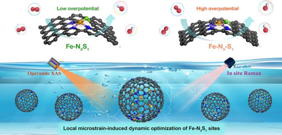Home > Press > Deciphering local microstrain-induced optimization of asymmetric Fe single atomic sites for efficient oxygen reduction
 |
| Crucial role of local microstrain was deciphered to boost oxygen electrocatalysis via quantitatively riveting asymmetric FeN3S1 sites on carbon hollow nanospheres with specific curvature.
The local microstrain accelerates kinetics of *OH reduction on FeN3S1, enabling much enhanced intrinsic activity, selectivity and stability toward oxygen electrocatalysis. The strained FeN3S1 sites were monitored to transformed into FeN3S1 sites, further dynamically mitigating the overadsorption of *OH intermediates. Credit Peng Zhang, Siying Huang, Kuo Chen, Xiaoqi Liu, Yachao Xu, Yongming Chai, Yunqi Liu, Yuan Pan. |
Abstract:
Oxygen electrocatalysis stands at the heart of next-generation metalair batteries and fuel cells, yet the age-old trade-off between activity and durability persists. Now, a joint team from the State Key Laboratory of Heavy Oil Processing at China University of Petroleum (East China) and Peking University, led by Professor Yuan Pan, reveals how local microstrain can be exploited as a precise tuning knob for single-atom catalysts (SACs). Their study, published in Nano-Micro Letters, demonstrates that curvature-controlled strain on hollow carbon nanospheres unlocks record-setting ORR performance and long-term stability.
Deciphering local microstrain-induced optimization of asymmetric Fe single atomic sites for efficient oxygen reduction
Shanghai, China | Posted on August 8th, 2025
Why Microstrain Matters
Asymmetric Coordination Breakthrough: Replacing one N with S in the classic FeN4 plane forms FeN3S1 moieties, disrupting symmetry and alleviating over-adsorption of *OH intermediates.
Curvature-Induced Strain: A 20 nm hollow nanosphere imposes 1.3 % compressive strain on FeN bonds and 1.5 % tensile strain on FeS bonds, down-shifting the Fe d-band center and accelerating *OH desorption kinetics.
Dynamic Self-Optimization: Operando XAS and in-situ Raman reveal that the strained FeS bond selectively breaks under high over-potentials, converting FeN3S1 into FeN3 and further mitigating *OH poisoning while preserving FeN integrity.
Engineering the Strained Architecture
One-Pot Silica-Templated Route: Coal-tar pitch, melamine and hemin chloride co-assemble around sacrificial SiO2 spheres (20 nm vs. 180 nm), followed by NH3 pyrolysis at 900 °C and HF etching to yield FeNS-HNS-20 with tunable curvature.
Quantitative Active-Site Density: AC-HAADF-STEM confirms 0.31 nm inter-atomic spacing and isolated dispersion; nitrite-stripping quantifies 6.2 e⁻ s-1 site-1 turnover frequency (TOF), 1.7× that of flat analogues.
Bifunctional Durability: After 20 000 ORR cycles, half-wave potential loss is Characterizing the Strain Effect
Operando Spectroscopy: Fe K-edge XANES tracks FeS bond elongation and subsequent rupture at 0 V vs. RHE, evidenced by coordination number drop from 0.9 → 0.2.
DFT Free-Energy Landscape: Strained FeNS-HNS-20 lowers the *OH desorption barrier to 0.73 eV, compared with 0.87 eV for flat FeNS-NS, aligning with measured Tafel slopes and RRDE electron-transfer numbers (n ≈ 3.97).
Device-Level Validation: Rechargeable Znair batteries deliver 214 mW cm-2 peak power density and 2200 cycles (1100 h) without voltage decaysurpassing Pt/C (184 mW cm-2, Future Outlook
Curvature Library Expansion: Extending the strategy to Co-, Ni-, or Mn-SACs could universalize strain-tunable electrocatalysis.
Scalable Fiber Electrodes: Hollow nanospheres can be spray-coated or electro-spun into gas-diffusion layers for kW-scale fuel-cell stacks.
Solid-State Integration: The same geometric strain principle is being adapted for solid-state Znair pouch cells, targeting >400 Wh kg-1 gravimetric energy.
By translating nanoscopic curvature into controllable bond strain, the Chai team transforms single-atom catalysts from static motifs into dynamically self-optimizing centers, pushing metalair technology ever closer to commercial reality.
####
For more information, please click here
Contacts:
Bowen Li
Shanghai Jiao Tong University Journal Center
Office: 021-62800059
Copyright © Shanghai Jiao Tong University Journal Center
If you have a comment, please Contact us.
Issuers of news releases, not 7th Wave, Inc. or Nanotechnology Now, are solely responsible for the accuracy of the content.
News and information
![]()
Sensors innovations for smart lithium-based batteries: advancements, opportunities, and potential challenges August 8th, 2025
![]()
Lab to industry: InSe wafer-scale breakthrough for future electronics August 8th, 2025
![]()
New imaging approach transforms study of bacterial biofilms August 8th, 2025
Possible Futures
![]()
ICFO researchers overcome long-standing bottleneck in single photon detection with twisted 2D materials August 8th, 2025
![]()
New molecular technology targets tumors and simultaneously silences two undruggable cancer genes August 8th, 2025
![]()
Simple algorithm paired with standard imaging tool could predict failure in lithium metal batteries August 8th, 2025
![]()
First real-time observation of two-dimensional melting process: Researchers at Mainz University unveil new insights into magnetic vortex structures August 8th, 2025
Discoveries
![]()
ICFO researchers overcome long-standing bottleneck in single photon detection with twisted 2D materials August 8th, 2025
![]()
New molecular technology targets tumors and simultaneously silences two undruggable cancer genes August 8th, 2025
![]()
Simple algorithm paired with standard imaging tool could predict failure in lithium metal batteries August 8th, 2025
![]()
First real-time observation of two-dimensional melting process: Researchers at Mainz University unveil new insights into magnetic vortex structures August 8th, 2025
Announcements
![]()
Sensors innovations for smart lithium-based batteries: advancements, opportunities, and potential challenges August 8th, 2025
![]()
Japan launches fully domestically produced quantum computer: Expo visitors to experience quantum computing firsthand August 8th, 2025
![]()
ICFO researchers overcome long-standing bottleneck in single photon detection with twisted 2D materials August 8th, 2025
![]()
New molecular technology targets tumors and simultaneously silences two undruggable cancer genes August 8th, 2025
Interviews/Book Reviews/Essays/Reports/Podcasts/Journals/White papers/Posters
![]()
New molecular technology targets tumors and simultaneously silences two undruggable cancer genes August 8th, 2025
![]()
Simple algorithm paired with standard imaging tool could predict failure in lithium metal batteries August 8th, 2025
![]()
First real-time observation of two-dimensional melting process: Researchers at Mainz University unveil new insights into magnetic vortex structures August 8th, 2025
![]()
Lab to industry: InSe wafer-scale breakthrough for future electronics August 8th, 2025
Battery Technology/Capacitors/Generators/Piezoelectrics/Thermoelectrics/Energy storage
![]()
Sensors innovations for smart lithium-based batteries: advancements, opportunities, and potential challenges August 8th, 2025
![]()
Simple algorithm paired with standard imaging tool could predict failure in lithium metal batteries August 8th, 2025
![]()
Enhancing power factor of p- and n-type single-walled carbon nanotubes April 25th, 2025
Fuel Cells
![]()
Current and Future Developments in Nanomaterials and Carbon Nanotubes: Applications of Nanomaterials in Energy Storage and Electronics October 28th, 2022










